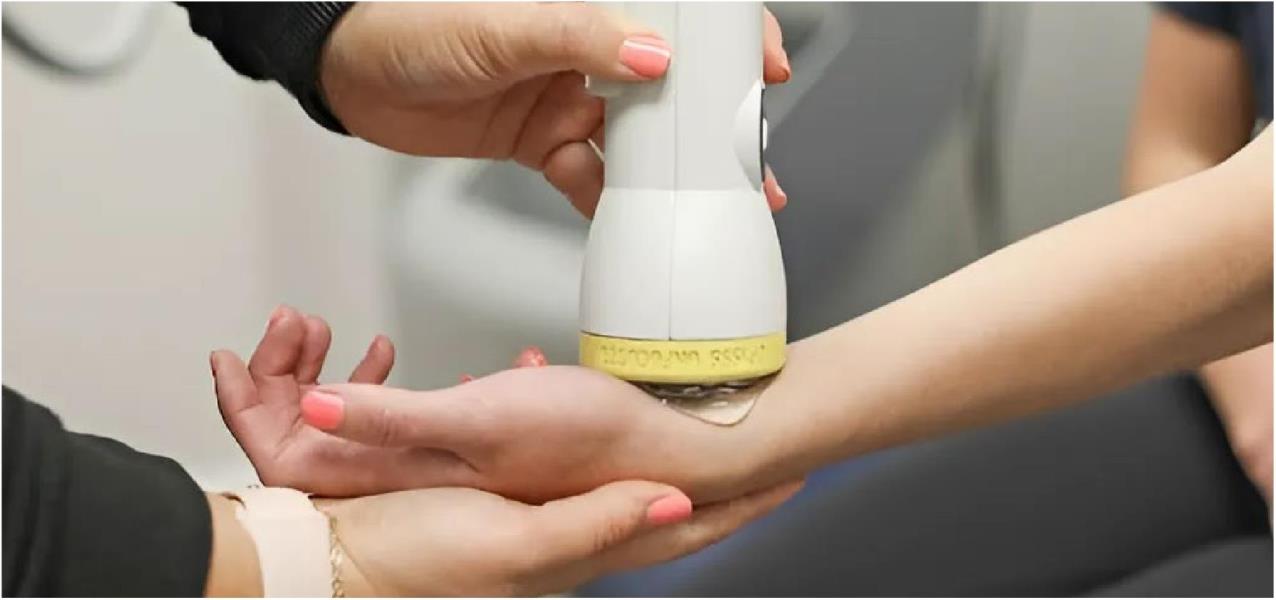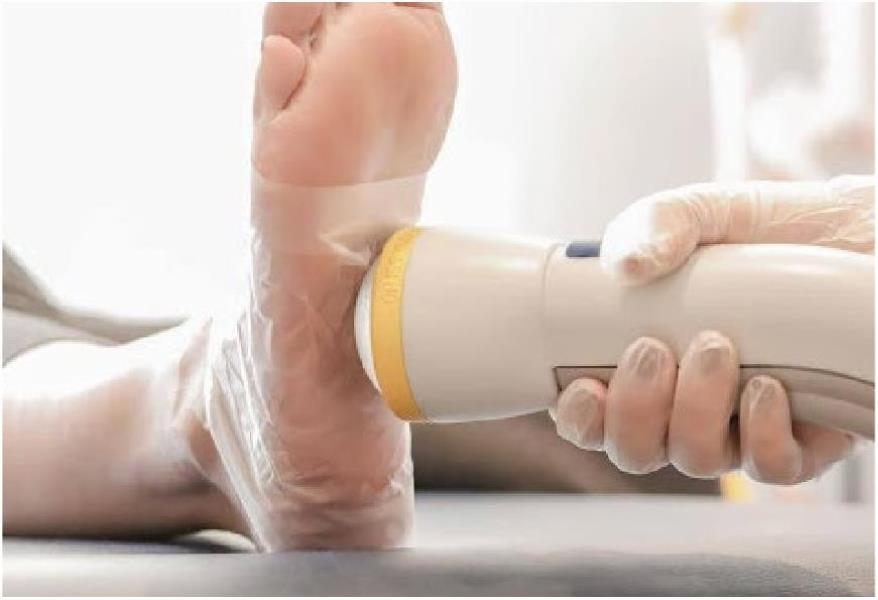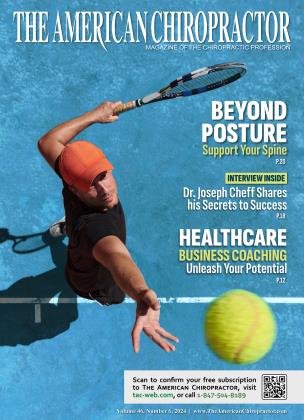Integrating Reflexology with Shockwave for Incredible Outcomes
June 1 2024 Matt DiDuroIntegrating Reflexology with Shockwave for Incredible Outcomes
June 1 2024 Matt DiDuroWhat if Combining the Old with the New Could Unlock a Revolutionary Way to Heal the Body Faster and More Effectively?
Integrating Reflexology with Shockwave for Incredible Outcomes
By Matt DiDuro, DC
Did you know that your feet and hands could be the key to alleviating back pain? When you combine reflexology and shockwave, you get a powerful formula to help more patients get back to living their best lives.
The Alliance Between Reflexology and Chiropractic Techniques
Reflexology operates on the premise that certain regions on the hands and feet are intricately connected to various organs and body systems. (See charts) This method suggests that targeted pressure can stimulate health and healing. The research suggests1 positive outcomes can be gained in the management and improvement of symptoms across a range of conditions. When enhanced with shockwave technology’s capabilities, these therapeutic effects are magnified.
Advanced Shockwave Therapy Unveiled
Representing the cutting edge of pain relief and tissue healing, shockwave therapy (often referred to as ESWT) includes electrohydraulic, electromagnetic, and piezoelectric modalities. This noninvasive technology promises to elevate chiropractic treatment through its stimulus of natural repair mechanisms, mitigating pain and accelerating tissue repair.
But how does this technology specifically benefit reflex points on hands and feet?
Blending Tradition with Innovation
Applying shockwave technology to reflex points on hands and feet offers a dual-stimulus healing strategy. This approach doesn’t just target reflex areas but also leverages technology for deeper tissue recovery and analgesia. The critical question is how can chiropractors effectively integrate this into their practice?
Practical Application and Insightful Research
Incorporating this integrated approach has shown promising outcomes. For instance, research indicates that shockwave technology can enhance the efficacy of reflexology, particularly in pain management and healing acceleration.2
John Warlick, the innovator behind SoftWave TRT, has witnessed the transformative power of electrohydraulic acoustic sound wave therapy throughout his 40-plus-year career. “The results can only be described as miraculous,” he shared. “Patients are often astonished by the ‘extra’ benefits that seem to arise naturally from the treatment.”
Warlick recounts the story of a 90-year-old patient who had been plagued by excruciating back pain for years, to the extent that sitting down was a challenge. A regimen of shockwave therapy targeting the patient’s back, hips, and hands yielded more than just pain relief. It delivered a surprising bonus. The treatment inadvertently provided respite from nocturia as well, reducing the patient’s nightly interruptions from as many as six times to just once.
With this comprehensive approach, the patient was spared from undergoing back surgery and gained the invaluable benefit of a good night’s sleep. “Given that there are no adverse side effects, we encourage our providers to consider, ‘Why not give it a try?’” said Warlick.
Researched
To support the integration of reflexology and shockwave technology in chiropractic care, several research findings offer valuable insights. Reflexology has demonstrated efficacy in various clinical settings. Studies3 have found that reflexology can reduce anxiety, manage pain, and improve symptoms in cancer patients undergoing chemotherapy. Another study notes foot reflexology was effective in attenuating chest pain.4
Furthermore, reflexology’s impact extends beyond oncology. It has shown potential benefits in managing symptoms for individuals with diabetes, migraine, multiple sclerosis, and postoperative care. Reflexology has been associated as effective as drug therapy in treating migraine headaches,5 and could reduce fatigue in women with multiple sclerosis.6
 “I was skeptical when my doctor suggested treating my menstrual cramps with shockwave therapy on my wrists. But I was completely surprised by the positive results. The pain relief was significant, and the best part is no more monthly pain meds," said patient Cindy O.
“I was skeptical when my doctor suggested treating my menstrual cramps with shockwave therapy on my wrists. But I was completely surprised by the positive results. The pain relief was significant, and the best part is no more monthly pain meds," said patient Cindy O.
Shockwave technology has been recognized for its effectiveness in various medical fields, including orthopedics, urology, and wound care.
Integrating these two modalities offers a comprehensive approach in chiropractic care, enhancing patient outcomes by leveraging the benefits of reflexology’s targeted pressure on specific reflex points and shockwave technology’s broad tissue stimulation and healing promotion. This combination provides a powerful tool for chiropractors seeking to expand their treatment capabilities and offer holistic, noninvasive solutions to their patients.
Streamlined Care
Integrating reflexology into chiropractic care offers a streamlined and efficient approach. It is not only practical but also time-efficient, allowing practitioners to offer comprehensive care seamlessly within a standard treatment session. The practitioner can target specific reflex points in the hands or feet to correspond with the patient’s needs, all within the usual timeframe of a chiropractic appointment. A chiropractor can provide an added layer of therapeutic intervention without significantly extending the duration of the visit.

Shockwave therapy generates a great biological response when treating the hands and feet because of its unique mechanism of action that stimulates the body’s natural healing processes. When shockwaves are applied in the targeted tissue, they initiate a cascade of biological responses.
Enhanced Blood Flow: Shockwaves promote the formation of new blood vessels (angiogenesis), improving blood circulation in the treated area. This increased blood flow brings essential nutrients and oxygen, crucial for tissue healing and regeneration, especially in areas like the hands and feet, which are dense with nerve endings and small vascular structures.
Stimulating Cellular Repair: The mechanical stress induced by shockwaves triggers cellular responses, leading to the release of growth factors and the stimulation of stem cells. This process accelerates tissue repair and regeneration.
Pain Reduction: Shockwave therapy has been shown to have a direct analgesic effect, reducing pain and inflammation.
Targeted Treatment: Applying shockwave therapy to specific reflex points linked to different body parts and systems can produce systemic effects, enhancing overall well-being and not just localized healing.
Please be sure to do your homework when reviewing shockwave device options. Many shockwave devices stimulate microtrauma while an electrohydraulic device uses broad-focus energy waves that reach wider and deeper without microtrauma.
By combining shockwave therapy with reflexology, practitioners can leverage the benefits of both the precise, targeted approach of reflexology and the deep tissue stimulation of shockwave therapy, offering a comprehensive treatment modality for chiropractors to adopt and treat more patients. It’s a game-changer for patients and providers.
About the Author
Matt DiDuro, DC, offers specialized neuropathy and chiropractic care at ATL Pain Institute in Alpharetta and Atlanta, Georgia. With more than 29 years in health care, DiDuro is a former director of Life University’s Rehab Center and an advocate for shockwave treatments. Reach him at [email protected], 855-285-7246, or www.softwavetrt.com.
Fun Facts: Hands and Feet in Focus
Did you know that the spinal reflex area in reflexology is predominantly located on the inner edges of the feet? This means that focusing on these specific foot zones can be particularly effective for back or shoulder issues. Similarly, the hands contain reflex points linked to the spine and shoulder, found on the thumb and the base of the hand, offering additional avenues for treatment.
Reflexology is an entirely different practice from massage. This form of practice is carried out using maps with predefined points located on the feet and hands. As mentioned, these points are directly linked to your nervous system, affecting the glands and other bodily organs.
Here’s a general overview of the zones in hand and foot reflexology:
Feet Reflexology Zones
The Toes: Each toe corresponds to the head and neck. The big toe is often associated with the head and brain, while the other toes relate to the sinuses, eyes, and ears.
The Ball of the Foot: This area is connected to the chest region, including the heart and lungs.
The Arch of the Foot: This zone reflects the internal organs that lie within the body’s midsection, like the liver, pancreas, and kidneys.
The Heel: The heel corresponds to the lower part of the body, including the lower back, intestines, and sciatic nerve.
The Inner and Outer Edges of the Foot: These areas correspond to the spine, with the inner edge reflecting the spine’s alignment and the outer edge associated with the shoulders and arms.
Hand Reflexology Zones
The Fingers: Similar to the toes, the fingers correspond to the head and neck. The fingertips are linked to the head and brain, while the lower parts of the fingers relate to the neck and sinuses.
The Palm: The palm of the hand is divided into zones that correspond to the body’s organs, with the lower part of the palm relating to the lower body organs and the area around the base of the thumb connecting to the neck and head.
The Back of the Hand: This area is less frequently referenced in reflexology but is considered to reflect the back and shoulders.
The Wrist: It is often seen as a reflex point for the reproductive system and the lymphatic system.
References
Whatley J, Perkins J, Samuel C. Reflexology: exploring the mechanism of action. Complement Ther Clin Pract. 2022 Aug;48:101606. doi: 10.1016/j.ctcp.2022.101606. Epub 2022 May 18. PMID: 35613519.
Eghbali M, Safari R, Nazari F, Abdoli S. The effects of reflexology on chronic low back pain intensity in nurses employed in hospitals affiliated with Isfahan University of Medical Sciences. Iran J Nurs Midwifery Res. 2012 Mar;17(3):239-43. PMID: 23833620; PMCID: PMC3696219.
Mannion, W. How does reflexology work anyway? [Internet] Dublin (Ireland) Reflexology with Wendy [cited 2024 March]. Available from https://www.reflexologywithwendy.com/learn.
Nazari F, Shahreza MS, Shaygannejad V, Valiani M. Comparing the effects of reflexology and relaxation on fatigue in women with multiple sclerosis. Iran J Nurs Midwifery Res. 2015 Mar-Apr;20(2):200-4. PMID: 25878696; PMCID: PMC4387643.
 View Full Issue
View Full Issue









